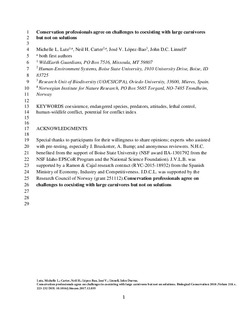| dc.contributor.author | Lute, Michelle L. | |
| dc.contributor.author | Carter, Neil H. | |
| dc.contributor.author | López-Bao, José V. | |
| dc.contributor.author | Linnell, John Durrus | |
| dc.date.accessioned | 2018-01-11T14:02:22Z | |
| dc.date.available | 2018-01-11T14:02:22Z | |
| dc.date.created | 2018-01-03T10:48:55Z | |
| dc.date.issued | 2018 | |
| dc.identifier.citation | Biological Conservation. 2018, 218 223-232. | nb_NO |
| dc.identifier.issn | 0006-3207 | |
| dc.identifier.uri | http://hdl.handle.net/11250/2477051 | |
| dc.description.abstract | Although many studies explore characteristics of stakeholders or publics “for” or “against” large carnivores, disagreements among conservation professionals advocating different conservation strategies also occur, but are not well recognized. Differing viewpoints on whether and how humans can share landscapes with large carnivores can influence conservation policies. To characterize current viewpoints about terrestrial large carnivore conservation, we conducted an online survey assessing a wide range of viewpoints about large carnivore conservation among international professionals (n =505). We explored how variation in viewpoints was related to expertise, background, and broader institutional contexts in which one lives and works. The majority of participants agreed people and large carnivores can share the same landscapes (86%). Human adaptation to carnivores (95% agreement) and acceptance of some conflict (93%) were the highest ranked requirements for humancarnivore coexistence. We found broad consensus regarding intrinsic value of carnivores, reasons carnivores are imperilled, conflict drivers, and importance of proactive solutions, such as adopting preventative livestock husbandry methods or avoiding situations that put people at risk. The greatest polarization was observed in issues related to lethal control, where we only found broad consensus for killing carnivores in situations where humans are in immediate risk. Participants opposed the killing of large carnivores when objectives were to decrease population sizes or increase human tolerance, profits, livelihoods, or fear of humans. Results point to considerable diversity, perhaps driven by local context, concerning how to proceed with large carnivore conservation in the increasingly human-influenced landscapes of the Anthropocene. The different observed viewpoints represent both different strategies about how to best conserve, but also different moral platforms about what, how, where, and for whom conservation should occur. Our study underlines that challenges to adopting and implementing long-lasting carnivore conservation strategies may well occur as much within the conservation community as outside it. Coexistence Endangered species Predators Attitudes Lethal control Human-wildlife conflict Potential for conflict index | nb_NO |
| dc.language.iso | eng | nb_NO |
| dc.rights | Attribution-NonCommercial-NoDerivatives 4.0 Internasjonal | * |
| dc.rights.uri | http://creativecommons.org/licenses/by-nc-nd/4.0/deed.no | * |
| dc.title | Conservation professionals agree on challenges to coexisting with large carnivores but not on solutions | nb_NO |
| dc.type | Journal article | nb_NO |
| dc.type | Peer reviewed | nb_NO |
| dc.description.version | acceptedVersion | nb_NO |
| dc.subject.nsi | VDP::Zoologiske og botaniske fag: 480 | nb_NO |
| dc.subject.nsi | VDP::Zoology and botany: 480 | nb_NO |
| dc.source.pagenumber | 223-232 | nb_NO |
| dc.source.volume | 218 | nb_NO |
| dc.source.journal | Biological Conservation | nb_NO |
| dc.identifier.doi | 10.1016/j.biocon.2017.12.035 | |
| dc.identifier.cristin | 1534489 | |
| dc.relation.project | Norges forskningsråd: 251112 | nb_NO |
| cristin.unitcode | 7511,2,0,0 | |
| cristin.unitname | Avdeling for terrestrisk økologi | |
| cristin.ispublished | true | |
| cristin.fulltext | postprint | |
| cristin.qualitycode | 1 | |

